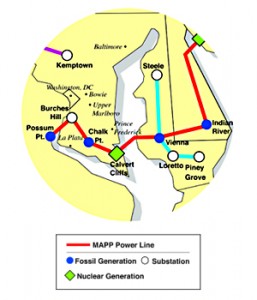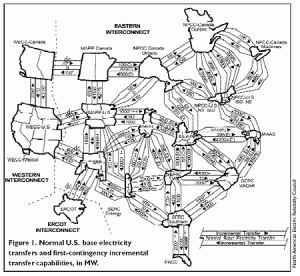MAPP transmission line under the microscope
September 26th, 2009
Before we get started, a note about need. As usual, this transmission line is not needed. PEPCO’s Mid-Atlantic Power Pathway, or MAPP line, not to be confused with Mid-Continent Area Power Pool (MAPP), is the red line on the map above. PJM, the private utility transmission promotion entity, has admitted that the Indian River to Salem part of the line is not justified, and have taken it off their wish list. Now, about the rest of it…
And where did MAPP come from? It’s part of Project Mountaineer, which is planned to bring cheap coal generation from the Amos plant and others, like the coal plant planned by Delaware Electric Co-op. Without this transmission line, the coal generation would not be used in the Mid-Atlantic or parts further NE, i.e., New York.
The MAPP transmission line had a day of scrutiny last week when MAPP opposition groups hosted a tour and luncheon featuring former Maryland Gov. Harry Hughes speaking against the line. State Senators and staff from both Maryland U.S. Senators were present, and it looks like they got an earful and eyeful! They used balloons to show the height of the lines, as we did in Susquehanna-Roseland last month, and Chisago years ago.
Here’s the full story:
Tour focuses on MAPP problems
By DUSTIN HOLT Special from The Star DemocratPublished: Friday, September 25, 2009 9:56 AM CDT
The Eastern Shore Land Conservancy and the Dorchester Citizens for Safe Energy along with the Dorchester County Tourism Department organized a tour through Dorchester County last week to show the impact the proposed Mid-Atlantic Power Pathway project would have on the county’s heritage, agriculture and wildlife.
Pepco Holdings is proposing a 27-mile high-voltage electrici transmission line crossing Dorchester County as part of the MAPP project, from Taylor’s Island to Vienna.
The ESLC suggests the towers would be 150 feet tall, though Pepco puts them between 110 and 130 feet. According to the ESLC, the towers would consume 650 acres of county agriculture, forest and rural lands.
The Sept. 16 tour included lunch at the E.A. Murphy Community Center in Vienna, with former Maryland Gov. Harry Hughes as a guest speaker.
“Many of us are opposed to it (the MAPP Project) because insufficient studies have been done for this line,” said Hughes, an advisory committee member of the ESLC. “Have they looked at alternatives?”
Hughes said one alternative is to improve the Vienna Power Plant, which is not operating at full power. He said another alternative is to introduce energy conservation standards to reduce the need for the power lines.
“This is a massive project that will disrupt the landscape,” Hughes said.. “There are too many unknowns with no alternatives considered. As far as I can see, there is no need to rush into this.”
Vienna Mayor Russell Brinsfield, one of the founders of ESLC, said MAPP would permanently and negatively impact Vienna. He said alternatives should include the state promoting energy conversation and renewable resources.
State Sen. Richard Colburn, R-37-Mid-Shore; Del. Addie Eckardt, R-37B-Dorchester; and Jeannie Haddaway-Riccio, R-37B-Talbot, were in attendance at the lunch in Vienna.
Eckardt said it is important to preserve the heritage and agriculture in the county, “Our biggest asset is our land, fisheries and agriculture.”
If MAPP project must move forward, Eckardt said, the state needs to look where the project will not be environmentally sensitive nor impair the landscape of the county.
The tour headed from Vienna, through Blackwater National Wildlife Refuge and back to Cambridge.
Dorchester Citizens for Safe Energy Chairman Libby Nagel said the power line would require about a 200-foot right-of-way.
To demonstrate the height of the towers, balloons were deployed to a height of about 150 feet.
Local farmer Lin Spicer said spraying crops would be ineffective with the power lines because planes would not be able to get below the lines. “We would be forced to spray from above the towers and the wind would blow the spray all around before it reached the crops,” he said.
Blackwater Manager Susan Baird said the MAPP towers would have a great impact on wildlife and wetlands. She said bald eagles need a living area of at least five miles. “They won’t fly over the towers, so you can’t tell me they or other birds will not move on to different locations outside of Dorchester County if the power lines are put here,” Baird said.
PEPCO may not finance MAPP transmission line
June 27th, 2009
And that’s a good thing, because their SEC filings show that demand is down from 2007-2007, as it is everywhere. It’s looking like utilities are unable to sustain their drive for long distance market dispatch, and if this trend is the reality, and their stock continues to be in the toilet, they can’t build their transmission dream — this is good news! Chalk up one for the economic depression!
All of us participating in the Delmarva Power IRP have to make sure the PSC knows about the tanked market, after all, they’re addressing how Delmarva Power will fulfill its demand, and for sure we don’t need new generation (need different generation, to be sure) or any transmission. As to needing different generation, it’s particularly important at this time to attach a requirement to SHUT DOWN FOSSIL FUEL to any RES. Without that, they’ll just sell it elsewhere, and we won’t gain anything.
Here’s one example of how the economy can have an impact on electric infrastructure and market. Hot off the press — PEPCO may not be selling stock to finance projects, and the biggest project they’re looking at is the much-detested Mid-Atlantic Power Pathway, electric transmission known as the MAPP line.
And remember, not that long ago, PJM cancelled the part from Indian River to Salem, NJ, at the Salem & Hope Creek nuclear plants. Here’s what it looks like now, supposedly:
HA! THEIR MAPS DON’T EVEN REFLECT THAT CHANGE!!
The Press Release says:
According to Gausman, PJM has also reviewed the need for the section of the line that would run from Delmarva Power’s Indian River substation near Millsboro, Del., to Salem, N.J., and has decided to move this portion of the line into its “continuing study” category. This means that the reconfigured MAPP line will now extend approximately 150 miles from northern Virginia, across southern Maryland and the Chesapeake Bay, and terminate at Indian River. The change would likely reduce the total project cost from $1.4 billion to $1.2 billion.
(Emphasis added). Hee hee hee hee hee — “… terminate at Indian River.” No Indian River to Salem, NJ section. Cutting a section out is just one more step to tanking the project. What’s the point of a radial line to Indian River? Some would say that “hey, there’s transmission there, it’s not a radial line,” but there’s NOT transmission there to facilitate the bulk power transfers coming in on a 500kV line. The system there is comparatively VERY low voltage. Others would note that the Indian River plant has two units shutting down, but folks, they’re the smallest units, totalling about 150MW or so, that will not make a big electrical difference, though it has a significant impact on our ability to breathe the air in southern Delaware! Taking the small Indian River units most probably means that Bluewater Wind should have no problem interconnecting — lets see the interconnection studies with Indian River units off line!
Anyway, here’s the poop — and look at the PEPCO price: $13.39, about half of what it was a year ago ($26.25) (for month, YTD, year and 5 year, go HERE) If you look at the 5 year trend, it’s the same reflected in Xcel’s demand — everything goes south in 2007. THIS IS NOT A “BLIP” FROM LAST FALL’S CRASH, this is a 2 year, nearly 3 year trend. (For Xcel month, YTD, year and 5 year, go HERE).
From PEPCO’s 2008 SEC 10-K, here’s their 2007-2008 energy delivery numbers (DOWN), regulated and default:
|
Regulated T&D Electric Sales (Gigawatt hours (GWh))
|
||||||||||
|
2008
|
2007
|
Change
|
||||||||
|
Residential
|
17,186
|
17,946
|
(760)
|
|||||||
|
Commercial
|
28,739
|
29,137
|
(398)
|
|||||||
|
Industrial
|
3,781
|
3,974
|
(193)
|
|||||||
|
Other
|
261
|
261
|
–
|
|||||||
|
Total Regulated T&D Electric Sales
|
49,967
|
51,318
|
(1,351)
|
|||||||
|
Default Electricity Supply Sales (GWh)
|
||||||||||
|
2008
|
2007
|
Change
|
||||||||
|
Residential
|
16,621
|
17,469
|
(848)
|
|||||||
|
Commercial
|
9,564
|
9,910
|
(346)
|
|||||||
|
Industrial
|
640
|
914
|
(274)
|
|||||||
|
Other
|
101
|
131
|
(30)
|
|||||||
|
Total Default Electricity Supply Sales
|
26,926
|
28,424
|
(1,498)
|
|||||||
Here’s PEPCO 2007-7008 SEC 10-K info, 2006-6007, regulated and default – these numbers should be the same for the same years, and they’re not, what does that mean:
|
Regulated T&D Electric Sales (GWh)
|
||||||||||
|
2007
|
2006
|
Change
|
||||||||
|
Residential
|
17,946
|
17,139
|
807
|
|||||||
|
Commercial
|
29,398
|
28,638
|
760
|
|||||||
|
Industrial
|
3,974
|
4,119
|
(145)
|
|||||||
|
Total Regulated T&D Electric Sales
|
51,318
|
49,896
|
1,422
|
|||||||
|
Default Electricity Supply Sales (GWh)
|
||||||||||
|
2007
|
2006
|
Change
|
||||||||
|
Residential
|
17,469
|
16,698
|
771
|
|||||||
|
Commercial
|
9,910
|
14,799
|
(4,889)
|
|||||||
|
Industrial
|
914
|
1,379
|
(465)
|
|||||||
|
Other
|
131
|
129
|
2
|
|||||||
|
Total Default Electricity Supply Sales
|
28,424
|
33,005
|
(4,581)
|
|||||||
Here’s the PEPCO 2006 SEC 10-K info, their 2005-2006 energy delivery numbers (DOWN), first regulated sales:
| Regulated T&D Electric Sales (gigawatt hours (Gwh)) | |||||||||||
|
2006 |
2005 |
Change |
|||||||||
| Residential |
17,139 |
18,045 |
(906) |
||||||||
| Commercial |
28,638 |
29,441 |
(803) |
||||||||
| Industrial |
4,119 |
4,288 |
(169) |
||||||||
| Total Regulated T&D Electric Sales |
49,896 |
51,774 |
(1,878) |
||||||||
| Default Electricity Supply Sales (Gwh) | |||||||||||
|
2006 |
2005 |
Change |
|||||||||
| Residential |
16,698 |
17,490 |
(792) |
||||||||
| Commercial |
14,799 |
15,020 |
(221) |
||||||||
| Industrial |
1,379 |
2,058 |
(679) |
||||||||
| Other |
129 |
157 |
(28) |
||||||||
| Total Default Electricity Supply Sales |
33,005 |
34,725 |
(1,720) |
||||||||
CLICK HERE – PEPCO’s SEC 10-K filings for lots of years to do your own looking!
From Bloomberg:
Pepco CFO May Postpone Investment to Avoid Share Sale
Pepco fell 3 cents to $13.39 in composite trading on the New York Stock Exchange.
Mid-Atlantic’s MAPP line cut short
May 20th, 2009
PJM, Delmarva Power, PEPCO, PHI, whatever, admit that demand is down and that the Mid-Atlantic Power Pathway, the transmission line through Maryland and Delaware to New Jersey, should be delayed
The Mid-Atlantic Power Pathway, or MAPP, is part of PJM’s “Project Mountaineer,” a web of lines expressly designed to move coal generation from the Amos plant in West Virginia and gather other coal and nuclear generation and send it in a northeasterly direction:
See the MAPP line there in the NE section of Project Mountaineer line 4?
PJM has recommended delay of the inservice date for a portion of the MAPP line by a year, the portion from Indian River to Salem nuclear plant. What remains, however, is a problem, because electrically, it makes no sense to build a 500kV radial line to nowhere. If part of the line should be delayed, the ENTIRE line should be delayed.
Here’s the corporate Press Release and two “articles” which should be compared!
Press Release from Delmarva site
MAPP: Controversial High Voltage Electric Transmission Line Delayed for One Year
PJM Reinforces MAPP Need: Adds Year to Schedule (states “contributed by Delmarva Power”)
This demonstration of lack of need is something that should be raised in the Delmarva Power IRP docket, that demand is down so significantly that PJM thinks infrastructure construction should be delayed. And yes, PJM demand is way, way down.
So, since demand is so far down, this is a good time to let the PSC know, in the Delmarva Power IRP docket, that we know that demand is down, so far down that they can’t cover anymore and they have to postpone some of their infrastructure construction. The Hearing Officer is taking public comments on the Delmarva Power IRP until some time in July, I think the 25th.
Send IRP Public Comments to the Hearing Eximaner Ruth Price:
What’s an IRP Comment? The Integrated Resource Planning process is supposed to be the way a utility plans ahead to cover their demand, and it’s essentially the intersection of energy policy and those #(%&*)#*( utilities. This is the arena where it’s determined whether they should meet their demand through conservation (the cheapest and environmentally the smallest footprint), efficiency steps like load shifting and SmartGrid, offshore wind paired with natural gas for backup, and whether external costs of various generation options are taken into account. SOOOOO, does that give you an idea of what’s up?
See Delmarva Power’s IRP docket at the PSC, scroll down beyond that rulemaking on the top:
And note this sly trick — they couldn’t get their IRP right from last cycle and were told by PSC staff to take it home and try again, and the last revision of that last IRP is the one they submitted:
And they said in their accompanying letter that this one should be for THIS cycle! AAAAAAARGH!
So, it’s time to review this joke of an IRP, take a look at PJM load forecasting, look at PJM and PEPCO SEC filings like their 2008 10-K and 2009 1st Quarter 10-Q:
Dig up some good conservation reports and sent them in as examples of what can be done. Let them know that with PJM demand down, we expect some changes, that this is a good opportunity to take a sustainable fork in the road, when demand is down we can make conscious choices.
Once more with feeling, check out the Delmarva Power IRP and send comments to ruth.price@state.de.us.
Transmission for coal – FERC AD05-3
March 21st, 2009
Yes, all this transmission we see, the hard to believe plans of superhighways across the country, MTEP, JCSP, Green Power Express, TrAIL line, Mid-Atlantic Power Pathway, Susquehanna-Roseland, on and on and on, it’s for coal, we know that, but when the truth jumps up and is as in-your-face as it is at this meeting… well, ya gotta read it to believe it. From the FERC docket entitled PROMOTING REGIONAL TRANSMISSION PLANNING AND EXPANSION TO FACILITATE FUEL DIVERSITY INCLUDING EXPANDED USES OF COAL-FIRED RESOURCES (really, that’s the name…):
Here, from p. 61, is a tantalizing snippet from the Pres. of PJM:
PJM is certainly proud of what has been accomplished to date to open up markets to coal, but there is much more that we and others in this region can do to further enhance that use of coal.
It is for this reason that, today, PJM is setting out by example, a new initiative which we have labeled Project Mountaineer — appropriately titled for the state that we’re in — to utilize our regional transmission expansion planning process to explore ways to further develop an efficient transmission super highway, if you will, to deliver the low-cost coal resources in this region of the country, to market.
And to actually build it when people don’t want it over their land, don’t want to look at it, don’t want the EMF impacts? Well, they say…
About the only answer to that would be some sort of federal siting law that would basically overcome local property rights.
National Interest Electric Transmission Corridors anyone? This was in 2005… as the CapX Technical Report was about to be published, putting all of this into action… sigh….
To look up the entire docket, go HERE and search for AD05-3, and voila, there it is for your edification and reading enjoyment!
It’s all for coal, we know that, and we’ve got to NOT let them get away with this!
“What’s wrong with the electric grid?”
February 21st, 2009
Ever wonder what’s wrong with this electric grid that too many are spending too much time to fix? As in, “If it’s not broke, don’t fix it!” Here’s an article sent by Ann Rasmussen, of Dorchester Citizens for Safe Energy, fighting the Mid-Atlantic Power Pathway, that gives the best and most concise statement of the problem that I’ve found. Grappling with this will give you a solid context for understanding all the transmission proposals criss-crossing the US that we’ve seen lately.






